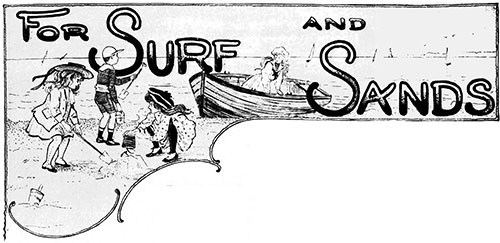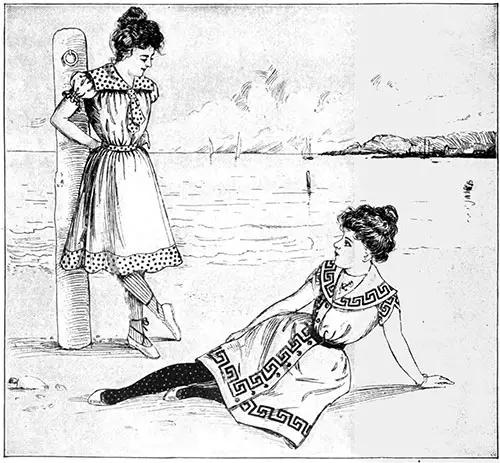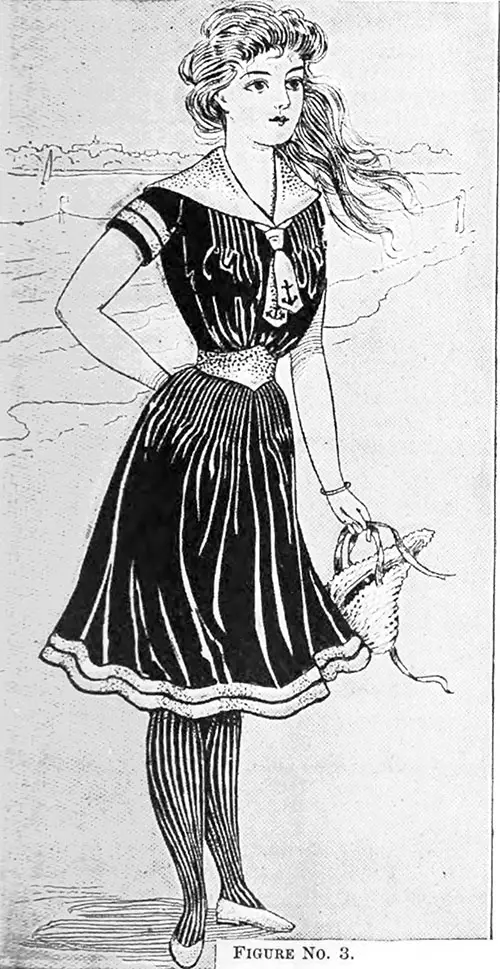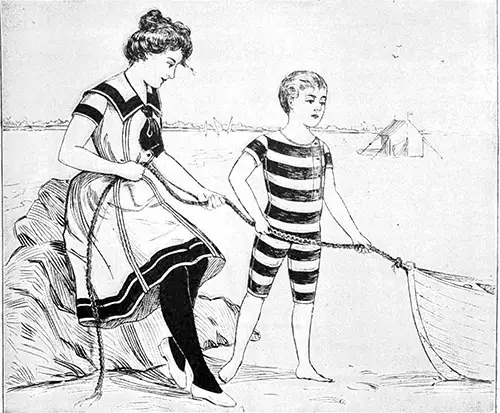Fashionable Bathing Costumes - July 1900

The fashion in bathing costumes changes each season as perceptibly as do the styles of gowns for ordinary wear, and to be dressed correctly and becomingly requires both taste and judgment. The chief attributes desirable in a bathing costume are comfort, durability, and attractiveness.
Tucks are introduced with pleasing effect in some of the latest modes, and the fullness at the back laid in an under box-plait is another interesting feature. In most cases, the knickerbockers and blouse are cut in one, but many women prefer tights, and when they are used the skirt is attached to the blouse. Canvas and ribbon belts are worn, and they will always harmonize with the decoration of the costume.
When it is desired to keep the hair dry. an oiled silk cap may be worn, over which can be artistically arranged a square of some pretty, bright colored silk in turban fashion. A large square in Oriental colors would be pleasing, with a sombre suit of black or dark blue.
Bathing slippers to protect the feet are recommended. Ribbons may be attached to the slippers and wound around the ankle in sandal effect. Stockings with cork soles are also worn.
Combinations are generally employed in bathing suits, though women of conservative tastes usually select a color that will not be conspicuous.
Black and dark blue combined with white are favorite choices, though red is often used in association with either by those to whom the touch of bright color is particularly becoming. Mohair, brilliantine, and alpaca are the materials best adapted to these garments.
Silk or satin is sometimes used, but more by those who favor the sands rather than the sea. Fine serge and flannel are also popular and may be made attractive with braid or bands of contrasting material.
The stockings chosen to wear when bathing should preferably be black, though styles showing dots of some pretty color or white on a dark ground are appropriate for youthful wearers.
Either flannel or stockinet may be used for men's and boys' suits, though the latter material is conceded to be more satisfactory and is more generally used. Caps to match are sometimes worn with these suits.
The illustrations show the season's newest and most approved designs in bathing costumes.

Bathing Costumes from 1900 - Figures 1 and 2 (l-r)
FIGURE No. 1.—This costume is particularly suited to slender figures. It is developed from white serge, royal-blue silk dotted with white being used for the sailor collar, belt and tie and to trim the bottom of the skirt.
The skirt is four-gored and full all around, and the bloused waist is cut in one with the knickerbockers. The sleeves are short puffs, and the becomingly low neck is outlined with a broad sailor-collar; a tie knotted in nautical fashion completes the blouse.
Royal blue stockings and white canvas slippers with white ribbons arranged around the ankles are worn with this attractive costume.
FIGURE No. 2 –Gray brilliantine, with black braid disposed in Grecian design for decoration was employed for this smart bathing costume.
The blouse is smooth at the top and is in V-outline at the front, revealing a buttoned-in shield which is outlined by the tapering ends of a sailor collar. The sleeve is short, and the blouse is in one with the drawers.
The skirt consists of two wide, circular portions and has an under box-plait at the back and is closed in front.

Bathing Costumes from 1900 - Figure 3
FIGURE No. 3.-The misses' costume here shown is decidedly stylish. Navy-blue and white serge were associated in the development.
The blouse is extended to form the drawers. Small tucks take up the fullness of the blouse at the top, and a sailor collar of white serge and knotted tie-ends of white silk with embroidered anchors done in blue silk, complete the low, V-shaped neck.
The sleeves are short, and tucks dispose of the fullness at the top of the straight skirt.

Bathing Costumes from 1900 - Figures 4 and 5 (l-r)
FIGURE No. 4.—An effective combination of black and white emphasizes the attractiveness of this smartly tucked bathing costume.
The blouse has a cluster of tucks at each side of the front and back, and the drawers are in one with the blouse. The slight V outline at the front of the blouse results in a becomingly low neck, and a sailor collar ornamented with a band of the black fabric gives attractive completion.
Tie-ends knotted in sailor fashion appear between the flaring ends of the collar. The skirt is in three-piece style and a panel effect is produced by groups of forward-turning tucks.
A similar group of backward-turning tucks is taken up at each side of the back, where the fullness is collected in gathers at the center. Black and white mohair were chosen for the costume.
FIGURE No. 5.–Dark blue-and-white striped stockinet was used for developing this boy’s bathing suit and narrow braid binds all the edges. The body and drawers are cut in one.
The neck is in slightly low outline, and the closing is made at the left side of the front. The short sleeves fit smoothly into the arm-hole.
"For Surf and Sands," in The Delineator, Paris-London-New York: The Butterick Publishing Co. Ltd., Vol. LVI, No. 1, July 1900, p. 48-49.
Editor's Note: Some terminology used in the description of women's clothing during the 1800s and early 1900s has been changed to reflect more modern terms. For example, a women's "Toilette" -- a form of costume or outfit has an entirely different common meaning in the 21st century. Typical terms applied to "toilette" include outfit, ensemble, or costume, depending on context.
Note: We have edited this text to correct grammatical errors and improve word choice to clarify the article for today’s readers. Changes made are typically minor, and we often left passive text “as is.” Those who need to quote the article directly should verify any changes by reviewing the original material.
